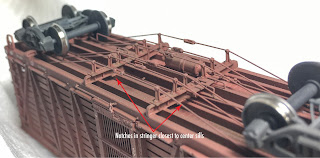 |
| San Diego, California, December 27, 1956, Col. Chet McCoid photo, Bob's Photo |
 |
| courtesy of Al Hoffman |
Until late 2018, the Nickel Plate car would have required a more formidable effort. However, the recent release by Kadee of the early version of the PS-1 makes things considerably easier. The main thing to be addressed, assuming one chooses to, is the underframe (aside from the number of panels, of course.) For the earlier cars Kadee opted to leave the underframe tooling from the original kit unchanged, even though it is not technically accurate. Early PS-1s used what was in essence a welded AAR underframe, while the Kadee model uses the later proprietary PS-1 underframe. I will cover my efforts to address that in the subsequent posts on modeling these cars.







